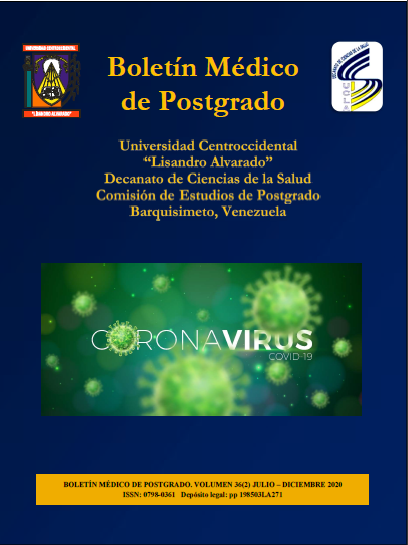Predisposing factors for laryngeal hyperfunction dysphonia in adult patients. Hospital Universitario Dr. Luis Gómez López
Keywords:
dysphonia, laryngeal hyperfunction, otorhinolaryngology, smoking, nasofibrolaryngoscopyAbstract
A retrospective review of 95 medical charts was carried out with the objective of determining the predisposing factors for laryngeal hyperfunction dysphonia in adult patients attending the otorhinolaryngology consult of the Hospital Universitario Dr. Luis Gómez López, during the period January-December 2016 to June 2017. The results show a male predominance (82.4%) and an age between 37 to 44 years in 96.8% of cases; 38% of patients are professionals exposed to environmental pollution and 25% are voice professionals; 79% of patients don’t smoke; 38% of cases abuse voice by speaking frequently, singing and shouting. 67.4% of patients have been exposed to vapors, 86.3% to tobacco smoke and 82.1% to firewood. Degree of dysphonia diagnosed by nasofibrolaryngoscopy was grade II (60%). Early detection of predisposing factors associated to laryngeal hyperfunction dysphonia is important in order to implement environmental actions to mitigate their influence in voice physiology.
Downloads
References
2. Cantor L. Análisis fono-ergonómico de la disfonía ocupacional en docentes. Influencia del espacio físico en la presencia de disfonía. Universidad de Colombia, Colombia; 2009.
3. Miranda M, Pazo T. Factores de riesgo vocal en locutores de la Unidad Provincial de Patrulla. Ciudad Habana, Cuba; 2008.
4. Reyes M. Prevalencia de los trastornos de voz ocupacionales en los docentes de dos Instituciones Educativas de Nivel Superior En Colombia. Año 2013- 2014. Colombia; 2014.
5. González A. La videoquimografía como parte del estudio multitest en el tratamiento de la disfonía funcional. Universidad de Murcia. España; 2012.
6. Halawa W, Caravaca-García A, Santos-Pérez S. Estudio epidemiológico de pacientes con disfonías funcionales. An ORL Mex 2012; 57(1): 44-50.
7. Moreno M. Frecuencia de disfonía en pacientes con rinosinusitis que acuden a la consulta de adultos del servicio de orrinolaringología en el Hospital Central Universitario Dr. Antonio María Pineda. Venezuela; 2014.
8. Kwan F. Desarrollo de disfonía en el ejercicio de la profesión docente. Universidad Nacional Experimental de Guayana. Venezuela; 2009.
9. Agostini Z. Prevalencia de disfonías funcionales en docentes argentinos. Aten fam 2013; 20(3): 81-85.
Published
How to Cite
Issue
Section
Las opiniones expresadas por los autores no necesariamente reflejan la postura del editor de la publicación ni de la UCLA. Se autoriza la reproducción total o parcial de los textos aquí publicados, siempre y cuando se cite la fuente completa y la dirección electrónica de esta revista. Los autores(as) tienen el derecho de utilizar sus artículos para cualquier propósito siempre y cuando se realice sin fines de lucro. Los autores(as) pueden publicar en internet o cualquier otro medio la versión final aprobada de su trabajo, luego que esta ha sido publicada en esta revista.



